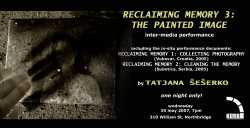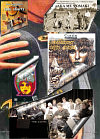page 6 of 7
3. The theoretical framework
The theoretical framework applies Carter’s notion of the “in-between spaces” to the described performative situations. The concept will be looked at in terms of the application of the cross-cultural background to the formal aspects of the performances. It will also be discussed in terms of communication process or monologue à deux of the simultaneous performances
The in-between space is a concept derived from Derrida’s deconstruction philosophy. However, through the work of Homi Bhabha and others the term has been applied to post-colonial and migrant situations to theorise an ambivalent ‘third’ space between departure and arrival. This transient space can become rich in expressive potential whilst addressing the possibility of artistic representation of identity. Paul Carter, an Australian cultural theorist and a sound artist of British descent, has done most to theorise and apply the aesthetic potential of the concept. For him in-between spaces are experienced phenomenologically in terms of movement rather than through static images, and hence are primarily fully somatic (i.e. bodily) rather than just visual. “Perhaps migrant’s new world is heard not seen; perhaps the experience of speaking for the first time is connected with [phonetic experience of] ‘states and movements in space.’” (Carter 1992, p.16)
Carter is particularly interested in the moment of first contact and the creative potential of initial attempts to map new spaces of translation between the self and the other and also to speak and understand the other, whose language we do not necessarily understand. In this process of attempting to understand translation, we apply verbal gestures of mimicry, and accompanying motions by the arms. In Carter’s sense, “this mimicry is not meant to parody communication, to undermine assertions of authority. It is a historical device for keeping the future open, for delineating a space where, in future, misapprehensions and differences can begin to form the basis of a new cross-cultural argot." (Carter 1992, p.13).
Drawing on Carter’s ideas the focus of directive communication forms its relationship with the consequential and simultaneous action. The dialogue between the two dominant geo-political and socio-cultural domains, Australia and former Yugoslavia is approached from the context of the multiplicity of transitions between cartographically remote urban spaces, between multiplicities of individual and collective memories. The two specified cultural spaces are defined by relationship of both disembodied and actual presence in the performative environment. Thus the collaborators set within “Other” urban contexts could portray the voice from the distance that informed the consequential action at the gallery space in Perth.
The in-between space has been appropriated to performances by the sense of the re-occurring loop between the self and the other. This can be seen through the possibilities of representation within space through multiplicity and assemblage of audio/video projected and performative information.
As Carter said, "the idea of improvised dialogue," or directive in the context of my performances, "changes the meaning of acting." A script of these performances was not so much about acting, but the processes that incorporate the presence of the body devoid of facial expressions in space and according to the script was meant to reinforce the transmitted imperative descriptions onto canvas.
"The voice we authorise," or that authorises us, "and cling to implies an imperium of silence." How we compose our surroundings determines how our surroundings are to be. The problem is not to preserve differences but to devise new movements between them. And if they are to succeed, the movements will have to be as much poetic as political." (Carter 1992, p.22). Poetics implies a world we would like to inhabit in terms of gaining some freedom of thought and spirit. The delineated space in between cannot be confined in a proleptic tradition of defining of postcolonial identity as an “attempt to give mimicry a respectable meaning.” (Carter 1992, p.22). Poetics implies also a fertile space between the history and politics.
page 6 of 7
Most [The Bridge]: Inter media performance - an article by Tatjana Seserko (Tatjana Šešerko)
 |
|||||||||||
| [Drama] | |||||||||||
 |
|||||||||||
| [Alexandria] | |||||||||||
|
Virtual Cultural Centre of WA |
|||||||||||




